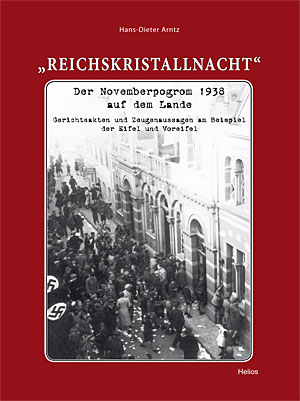![]()
![]() (English Version)
(English Version)
 It is not enough to prove the disputable facts – as proof of the destruction of Jewish property and many synagogues, as well as brute violence against Jewish citizens – historically. Rather should also Court the documents of the post-war period and corresponding sworn witness statements specifically investigated and analyzed. Much was forgotten, overlooked, or questionable judged from today’s perspective. The question of a jurisdiction sometimes no longer comprehensible in the occupation and the young Bundesrepublik may explain the real action at the “Nazi pogrom of 1938" differentiated.
It is not enough to prove the disputable facts – as proof of the destruction of Jewish property and many synagogues, as well as brute violence against Jewish citizens – historically. Rather should also Court the documents of the post-war period and corresponding sworn witness statements specifically investigated and analyzed. Much was forgotten, overlooked, or questionable judged from today’s perspective. The question of a jurisdiction sometimes no longer comprehensible in the occupation and the young Bundesrepublik may explain the real action at the “Nazi pogrom of 1938" differentiated.
Some things was historical and human, but different, when it was judged legally after World War II. What distinguishes this book from similar “Dokumentationen”, are the rare historic photos and evidence that “in the countryside”, where one knows the other person, much unlike ran as in the large cities. There was rarely the anonymity of the “arsonist in the robber civil” here, but here it was usually known fanatics from the neighborhood. This personal and social component so far impeded full research and evaluation, as well as the objective selection of archive documents and witness statements. The appearance of the “Reichskristallnacht” in the Eifel and Voreifel limited and thus focuses on a locally manageable space in the Rhineland, a specific part of the Eifel and Voreifel. It includes the towns of Bad Münstereifel, Zülpich and Sinzenich, Euskirchen and Flamersheim, Weilerswist and Lommersum, Mechernich and Kommern, Kall, Gemünd and Hellenthal/Blumenthal topographically and content.
The documentation so begins in the Middle Rhine area and ends in a westerly direction in a district Valley, which at the time was the November pogroms 1938 relatively isolated from the events in the cities of Bonn, Cologne and Aachen. Often, it will be noted that the riots in the microcosm of the Eifel were brutal than in the Rhenish cities. More than 10 houses were systematically destroyed in Mechernich and torn. The local group leader was acquitted after the 2nd World War, because he had been allegedly from “local political” and “technical reasons”. The Office Mayor of Hellenthal staged a “March of the pillory” after the in fire set of the Blumenthaler synagogue and belonged also to the accused in the “Schleidener Lynch Process”, which had to clarify the public shooting of an American pilot in September 1944 after the 2nd World War. The Euskirchener regional historian Hans-Dieter Arntz impressively combines his decades-long research into this documentation.
Hans-Dieter Arntz: “Reichskristallnacht” - The “Crystal Night” (1938) in the countryside – Court documents and testimonies on the example of the Eifel and Voreifel, Aachen 2008. (See: „REICHSKRISTALLNACHT“ – Der Novemberpogrom 1938 auf dem Lande as well as: http://www.philserv.com/helios-verlag-k-h-prohuber-documentation.html)
196 Pages, hard bound with dust cover, 280 pictures, 23 x 28 cm
ISBN 978-3-938208-69-4, 29,90 €
Helios-Verlag, Karl-Heinz Pröhuber
Brückstr. 48, 52080 Aachen, Tel.: 0241-555426
Tel.: 0241-555426
E-Mail: helios-verlag@t-online
www.helios-verlag.de
LINKS